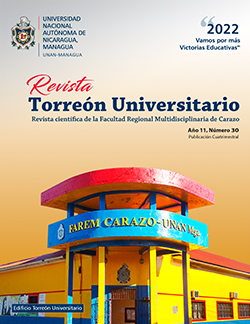Consolidating a vision on the education of the body. The case of the XII Pan American Congress of Physical Education, Guatemala 1989
DOI:
https://doi.org/10.5377/rtu.v11i30.13391Keywords:
congress, physical education, knowledge, experts, GuatemalaAbstract
From a socio-historical approach with emphasis on the social history of knowledge and experts (Neiburg y Plotkin, 2004; Heilbron, Guilhot, Jeanpierre, 2008; Altamirano, 2013), the following work analyzes the XII Pan American Congress of Physical Education held in Guatemala in 1989. The paper analyzes the event as a space for sociability, knowledge circulation, legitimation of certain experts, influence and power of some international organizations. Taking this into account, the purpose of the article is to examine the knowledge, experts and organizations that validated certain true meanings on how to conceptualize the wide universe of physical culture, physical education and sports (Scharagrodsky, 2011). To carry out the hermeneutical analysis, within the framework of a qualitative methodology, interpretive attention has been focused on various documentary sources, such as memoirs and reports of the congress, the central exhibitions, the general lectures and the memories related to other Pan American congresses. Likewise, a set of semi-structured interviews have been carried out. The analysis has articulated the “text” with the historical conditions of production and interaction of the investigated universe (Fairclough, 2003). Among the conclusions, the congress is identified as a space in which the educational discipline and sports transmitted different meanings about health. In addition, the congress made visible certain international experts and important transnational institutions linked to the heterogeneous field of physical culture.
Downloads
References
Comisión Nacional de Educación Física (1950). Informe del III Congreso Panamericano de Educación Física. Editada por la Comisión Nacional de Educación Física (CNEF).
Confederación Deportiva Autónoma de Guatemala (C.D.A.G.). (1989a). Memorias del XII Congreso Panamericano de Educación Física. Trabajos. Impreso por Organización Delgado.
Confederación Deportiva Autónoma de Guatemala (C.D.A.G.). (1989b). Memorias del XII Congreso Panamericano de Educación Física. Información preliminar. s/d.
Consejo Mexicano de Salud, Educación Física y Recreación (1982). Memoria del VIII Congreso Panamericano de Educación Física. Publicado por la Subsecretaría del Deporte.
Figueroa Ibarra, C., (2004). Protesta popular y cooptación de masas en Guatemala. Revista Venezolana de Economía y Ciencias Sociales, 10(1), 129-153. Recuperado en: https://www.redalyc.org/pdf/177/17710108.pdf
Foucault, M., (2007). Nacimiento de la biopolítica: Curso en el Collège de France (1978-1979). FCE.
Instituto Nacional de Deportes, Educación Física y Recreación (1987). Memorias del X Congreso Panamericano de Educación Física. Dirección de Propaganda/INDER.
McGehee, R. V., (1992). The rise of modern sport in Guatemala and the first central American games. The International Journal of the History of Sport, 9(1), 132-140. https://doi.org/10.1080/09523369208713785
Ministerio da Educação e Saúde (1945). Anais Primero Congreso Panamericano de Educação Física, Volume I. Imprensa Nacional.
Ministerio de Cultura y Educación (1971). Memoria del V Congreso Panamericano de Educación Física. Desarrollo y relatos. Talleres Gráficos Yunke.
Scharagrodsky, P., (2021). Cartografiando saberes, grupos ocupacionales, instituciones, agentes y redes. El caso del Segundo Congreso Panamericano de Educación Física, México, 1946. Revista Mexicana de Historia de la Educación, 9(17), 118-142. https://doi.org/10.29351/rmhe.v9i17.336
Scharagrodsky, P., (Comp.) (2011). La invención del homo gymnasticus. Fragmentos históricos sobre la educación de los cuerpos en movimiento en occidente. Prometeo.
Secretaría de la Defensa Nacional (1946). Memoria oficial del II Congreso Panamericano de Educación Física. Publicada por la Dirección Nacional de Educación Física y Enseñanza Premilitar.
Southwell, M., (2018). Enunciación, interpelación y producción de políticas educativas recientes. Preguntas desde la teorización del populismo. Revista Fermentario, 1(12), 70-88. https://doi.org/10.47965/fermen.12.1.6
Turner, B., (1989). El cuerpo y la sociedad. FCE.
Urrutia, E., (2013). Medio siglo de historia: los partidos políticos en Guatemala, 1954-2000. En C. Figueroa Ibarra, S. Tischler Visquerra, A. Taracena Arriola, V. Álvarez Aragón y E. Urrutia (eds.) Guatemala: Historia reciente (1954–1996) (pp. 263-309). FLACSO Guatemala. Recuperado en: http://www.flacso.edu.gt/publicaciones/wp-content/uploads/2014/03/FLACSO-Hisotria-reciente-Guatemala-Tomo-I-Reimpresion-2.pdf
Vera Guardia, C., (1998). Historia de los Congreso Panamericanos de Educación Física. Impresión Litografía Popular de Venezuela.
Zamora, J., (2008). Historia de la Educación Física en Guatemala. Edición Digital.
Heilbron, J., Guilhot, N. y Jeanpierre, L. (2008). Toward a transnational history of the social sciences. Journal of the History of the Behavioral Sciences, 44(2), 146-160. https://doi.org/10.1002/jhbs.20302
Altamirano, C., (2013). Intelectuales. Notas de investigación sobre una tribu inquieta. Siglo XXI.
Neiburg, F., y Plotkin, M. (Comps.) (2004). Intelectuales y expertos. La constitución del conocimiento social en la Argentina. Paidós.
Goodson, I., (2003). Estudio del currículum. Casos y métodos. Amorrortu Editores.
Fairclough, N., (2003). El análisis crítico del discurso como método para la investigación en ciencias sociales. En R. Wodak, y M. Meyer, (Comp.), Métodos de análisis crítico del discurso (pp. 179-204). Gedisa.
Vasilachis de Gialdino, I., (2007). Estrategias de investigación cualitativa. Gedisa.
Downloads
Published
Issue
Section
License
Copyright (c) 2022 National Autonomous University of Nicaragua, Managua (UNAN-Managua).

This work is licensed under a Creative Commons Attribution-NonCommercial-NoDerivatives 4.0 International License.
The authors who publish in this journal agree to the following terms.
- The author or authors of the articles, essays or research grant the National Autonomous University of Nicaragua, Managua (UNAN-Managua) the editing rights (copyright) of the submitted work, therefore the University has the exclusive right to publish the article for the entire copyright period.
- These copyrights/authors authorize Torreón Universitario Magazine and the University to edit and disseminate/publish the article in said Magazine, including printed and electronic reproduction, storage, retrieval and any other type of publication, and sources of secondary information as services. of summaries and databases, they also empower it to protect the article against unauthorized use for dissemination by printed or electronic media (PDF, HTML, EPUB, XML or others).
License for use of content
The magazine uses the Creative Commons Attribution-NonCommercial-NoDerivs 4.0 International License.
Under this statement:

This journal is licensed under a Creative Commons Attribution-NonCommercial-NoDerivatives 4.0 International License. It can be copied, distributed and transmitted publicly as long as the author and source are cited (Revista Torreón Universitario), it should not be modified or used for any commercial purpose. The full license can be found at http://creativecommons.org/licenses/by-nc-nd/4.0/.



